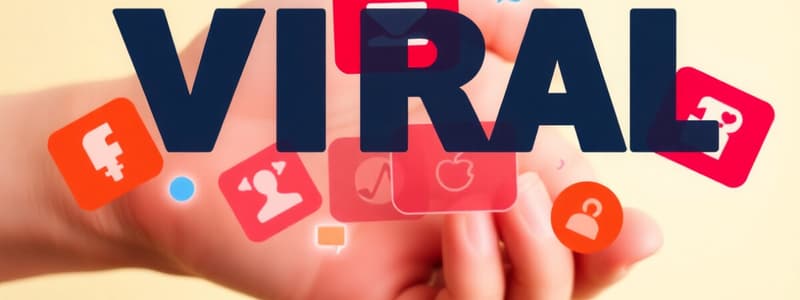Podcast
Questions and Answers
According to the podcast, what three elements are identified as key drivers of viral content, based on behavioral psychology?
According to the podcast, what three elements are identified as key drivers of viral content, based on behavioral psychology?
- Exclusivity, relatability, and humor.
- Controversy, emotion, and exclusivity.
- Humor, controversy, and exclusivity.
- Emotion, relatability, and timing. (correct)
Jonah Berger's STEPPS model identifies six factors that contribute to content virality. Which of the following is NOT one of those factors?
Jonah Berger's STEPPS model identifies six factors that contribute to content virality. Which of the following is NOT one of those factors?
- Social Currency
- Stories
- Triggers
- Ubiquity (correct)
The Ice Bucket Challenge is presented as an example of viral content that succeeded because it was:
The Ice Bucket Challenge is presented as an example of viral content that succeeded because it was:
- Expensive to produce and widely advertised.
- Simple, encouraged collective action, and was cause-driven. (correct)
- Complex, humorous, and celebrity-endorsed.
- Exclusive and difficult to replicate.
What is the primary reason that relatability is important for a post to go viral, according to the podcast?
What is the primary reason that relatability is important for a post to go viral, according to the podcast?
How do platforms use 'FOMO & Social Proof' to promote content?
How do platforms use 'FOMO & Social Proof' to promote content?
According to the discussion, why is repetition an important factor in the virality of short-form content?
According to the discussion, why is repetition an important factor in the virality of short-form content?
What is the primary way brands and creators capitalize on the psychology of virality, as mentioned in the podcast?
What is the primary way brands and creators capitalize on the psychology of virality, as mentioned in the podcast?
According to the podcast, what key element should brands keep in mind to ensure virality?
According to the podcast, what key element should brands keep in mind to ensure virality?
Which of the following best describes how Duolingo leverages virality?
Which of the following best describes how Duolingo leverages virality?
Why are great stories important for brands aiming for virality?
Why are great stories important for brands aiming for virality?
Flashcards
Drivers of Virality
Drivers of Virality
Emotion, relatability, and timing drive content to go viral.
STEPPS Model
STEPPS Model
Model with six factors that generate viral content: Social Currency, Triggers, Emotion, Public, Practical Value, and Stories.
Emotion in Viral Content
Emotion in Viral Content
Content that provokes happiness, anger, or amazement moves faster.
Relatability and Identity
Relatability and Identity
Signup and view all the flashcards
FOMO & Social Proof
FOMO & Social Proof
Signup and view all the flashcards
Short-form Content & Repetition
Short-form Content & Repetition
Signup and view all the flashcards
Timing for Brands
Timing for Brands
Signup and view all the flashcards
Genuine Content
Genuine Content
Signup and view all the flashcards
Study Notes
- The Psychology of Viral Content unlocks the secret formula to viral content
- Virality involves psychology, data crunching, and strategy.
The Science of Virality
- Studies suggest emotion, relatability, and timing drive content virality.
- Jonah Berger's STEPPS model consists of Social Currency, Triggers, Emotion, Public, Practical Value, and Stories.
- TikTok trends spread because they're simple and encourage collective action.
The Psychology of Shareability
- The human factor in virality is based on psychology.
- Emotion is content that provokes a strong emotional response, which moves faster.
- Relatability and Identity is when people post content that reflects their identity, which is why meme culture is successful.
- FOMO & Social Proof is when platforms designed to promote content that already has engagement, which strengthens because people don't want to miss out.
- Short-form Content & Repetition is when TikTok, Reels or Shorts use fast consumption and repeat exposure to get trends stuck in people's heads.
How Brands & Creators Leverage Virality
- Timing is key when jumping on viral challenges or memes to propel visibility.
- Viral content is often replicated with brands, like Duolingo's TikTok mascot, brand challenges, and interactive campaigns resulting in engagement and exposure.
- The most popular viral content is authentic, fun, and meaningful.
Studying That Suits You
Use AI to generate personalized quizzes and flashcards to suit your learning preferences.




